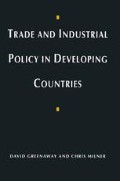Abstract
As we saw in Chapter 5, a great merit of the effective protection concept is that it provides a summary measure of the impact of trade interventions. As a result both input tariffs and output tariffs are incorporated. If the only distortions to relative prices are those present in the market for traded goods, this makes it a complete measure. However tariffs and non-tariff measures are not the only source of distortion to relative prices in developing countries. There are a range of other direct controls and fiscal measures that can result in a divergence of market prices and shadow prices. Good examples are price controls, minimum wage legislation, repatriation limits on profits, state trading companies and so on. The domestic resource cost (DRC) ratio is in the same genre as the effective protection coefficient. It is however a broader measure. It attempts to take all distortions in a particular sector or production process into account when calculating the social opportunity cost of a given activity. The technique is more demanding in its data requirements than effective protection. Nevertheless it has been relatively widely used.
Preview
Unable to display preview. Download preview PDF.
Author information
Authors and Affiliations
Copyright information
© 1993 David Greenaway and Chris Milner
About this chapter
Cite this chapter
Greenaway, D., Milner, C. (1993). Domestic Resource Cost Analysis. In: Trade and Industrial Policy in Developing Countries. Palgrave Macmillan, London. https://doi.org/10.1007/978-1-349-22782-2_6
Download citation
DOI: https://doi.org/10.1007/978-1-349-22782-2_6
Publisher Name: Palgrave Macmillan, London
Print ISBN: 978-0-333-46920-0
Online ISBN: 978-1-349-22782-2
eBook Packages: Palgrave Economics & Finance CollectionEconomics and Finance (R0)

